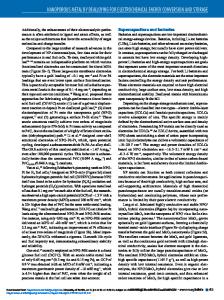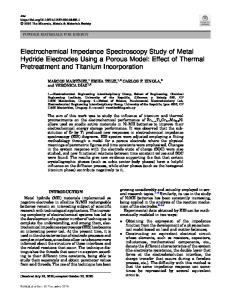Metal Hydride Alloys for Electrochemical Energy Source Applications
- PDF / 115,515 Bytes
- 5 Pages / 612 x 792 pts (letter) Page_size
- 10 Downloads / 280 Views
1042-S05-11
METAL HYDRIDE ALLOYS FOR ELECTROCHEMICAL ENERGY SOURCE APPLICATIONS Stoyan T Bliznakov1, Nikolay G Dimitrov2, Tony Spassov3, and Alexander Popov4 1 Chemistry, SUNY at Binghamton, P.O. Box 6000, Binghamton, NY, 13902-6000 2 Chemistry, SUNY at Binghamton, Binghamton, NY, 13902-6000 3 Chemistry, Sofia University, Sofia, 1126, Bulgaria 4 Bulgarian Academy of Sciences, Sofia, 1000, Bulgaria ABSTRACT High-capacity conventional and advanced multicomponent metal hydride alloys were synthesized in this work by two different methods. A set of AB5 –type intermetallic compounds, with different Al content, were produced by high-frequency vacuum induction melting method, while AB, A2B and mixed (AB5+Mg) -types composite nanocrystalline-amorphous alloys were obtained mechanochemically by high-energy ball milling in a planetary type mill. The alloys were characterized physically by XRD, SEM and thermodynamically by van’t Hoff’s plots derived from experimentally obtained PCT isotherms at various temperatures. Different optimized techniques for model electrode preparation from selected metal hydride alloys were also applied. The electrodes were charged-discharged electrochemically in concentrated alkaline solution. In this paper we compare the values for the electrochemical maximum capacity and cycle-life performance of the electrodes prepared by the investigated types of alloys. INTRODUCTION There have been continuous efforts to develop high energy density, high power density and low-cost rechargeable batteries that would meet the ever increasing needs for applications ranging from emergency backup, spacecraft, defense, and communications to electric vehicles, computers, camcorders, cellular phones, power tools and other home appliances. Although in recent years design and packaging of conventional storage batteries such as nickel cadmium, lead acid and lithium batteries have been considerably improved, there is still a great demand for better performance, more power and energy density. The innate toxicity of cadmium and lead has also come under scrutiny. The interest to metal hydride (MH) alloys was growing since late 1960’s because of their unique ability for reversible hydriding/dehydriding with high density, in some cases with a density even higher than that of liquid hydrogen. The ability for absorbing/desorbing hydrogen, either from gas phase or electrochemically, warrants suitability of these alloys as active materials in hydrogen storage units and in electrochemical energy sources. The electrochemical systems that currently use metal hydrides as anode materials are commercialized as rechargeable Ni-MH batteries. Future trends leading to higher energy density and lower cost of secondary cells when metal hydride anodes are used point toward possible replacement of the positive nickel electrode by a lighter air gas-diffusion electrode [1]. Currently, there are more than 2700 hydrogen storage materials [2] that have been described to reversibly store hydrogen at different pressures and temperatures but only few type
Data Loading...











